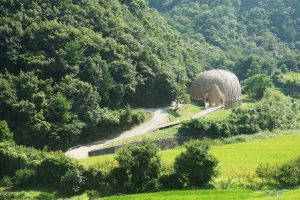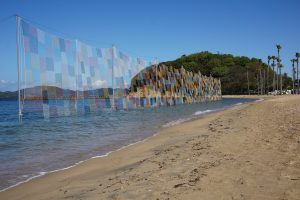Shiu Hong Simon TU
lifesimon[@]yahoo.com
The Chinese University of Hong Kong

Since the 2000s, the problem of aging and depopulation in rural Japan has been met with a new measure: contemporary art festivals (geijyutusai). While the notion of contemporary art (gendai āto) and geijyutusai had taken root in urban Japan in much earlier times, the emergence of large-scale art festivals for regional revitalization in rural Japan, pioneered by Echigo-Tsumari Art Triennale in 2000, could arguably be seen as an innovative breakthrough from both the perspective of Japanese art history and social policies. Although there is no official figure available on how many of these art festivals exist in Japan nowadays, it is commonly estimated that there are approximately one hundred to three hundred cases across the country, many of them funded by prefectural and/or municipal governments – very often making them some of the most visible revitalization projects on the local level.

Artist: Wen-chih Wang
Amidst the current discussions among art historians and cultural policy scholars on the context and effects of art festivals in Japan, this anthropological research aims to provide a comprehensive ethnographic account on the social and artistic processes behind, as well as the meanings to and agency of, individuals. For this research project, the geographical area hosting the Setouchi Triennale – twelve islands and two port cities in Kagawa and Okayama prefecture – was my primary field site, while the vast region intervened by Echigo-Tsumari Art Triennale in Niigata Prefecture was my secondary field site for supplementary data. I conducted preliminary fieldwork over the summers of 2017 and 2018; the formal fieldwork year began in September 2018 and continued through August 2019, allowing me to follow the preparation and development of the Setouchi Triennale 2019.

Does revitalization take place because of art festivals? If so, how does it relate to art? The research was first conceptualized by asking two sets of questions. To investigate the social process, I ask: How do different parties, including the bureaucrats of different levels, private sectors, universities, non-governmental organizations, and local inhabitants come into play behind of the making of Japanese art festivals? How do art festivals as socioeconomic policies influence the everyday lives of local inhabitants on the one hand, and correspond to new trends of domestic and international tourism on the other? Meanwhile, to scrutinize the particular role of art in relation to the larger social sphere, I also ask: How does the agency of local residents, artists, physical objects, and environmental factors interact, resulting in particular artistic manifestations? How does the agency of artworks affect local residents and communities?

Artist: Yasuaki Igarashi
At this point, whereas my fieldwork has concluded, my on-going analysis suggests that the effects of large-scale art festivals in rural Japan are not even. The official narratives of success, usually based on the stories of incoming migrants prompted by the art festivals in several highlighted locales, very often overshadow the actual reality of other locales where neither significant economic gains nor demographic gains have been observed. Similarly, the claim of artworks being able to regenerate social relations often overlooks the exploitative nature of, if any, such relations. However, echoing many of my key informants on the local level, I would point out that the potentials and affective nature of art, which can hardly be calculated quantitatively, do arguably shed a positive light on what art festivals mean to individual participants, and to revitalization in intangible and contentious ways.
I would appreciate any comments or suggestions via email. Thank you.
